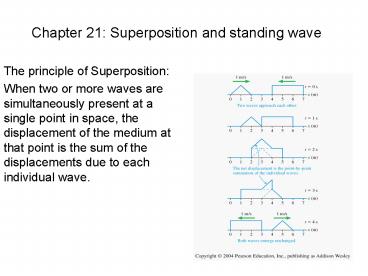Chapter 21: Superposition and standing wave PowerPoint PPT Presentation
Title: Chapter 21: Superposition and standing wave
1
Chapter 21 Superposition and standing wave
- The principle of Superposition
- When two or more waves are simultaneously present
at a single point in space, the displacement of
the medium at that point is the sum of the
displacements due to each individual wave.
2
Stop to think 21.1 page 648Stop to think
21.2 page 654Stop to think 21.3 page 658
- Example 21.1 page 651
- Example 21.2 page 654
- Example 21.5 page 656
- Example 21.6 page 658
3
Standing wave
- Ex there are two waves
- The resultant wave function is
Notice, in this function, does not contain a
function of (kx?t). So it is not an expression
for a traveling wave
4
Standing wave on a String
- A standing wave can exist on the string only if
its wavelength is one of the values given by - F1V/2L fundamental frequency.
- The higher-frequency standing waves are called
harmonics, - ex. m 2, second harmonics
- m3 third harmonics
Node
Antinode
5
Stop to think A standing wave on a string
vibrates as shown at the figure. Suppose the
tension is quadrupled while the frequency and the
length of the string are held constant. which
standing-wave pattern is produced
Answer a
6
Standing Sound Waves
- Open-open or closed-closed tube
m 1,2,3
7
Open-closed tube
8
Problem 21.54
- Model A stretched wire, which is fixed at both
ends, creates a standing wave whose fundamental
frequency is f1 V(wire)/2L. A standing wave in
an open-closed tube exhibits an antinode at the
open end and a node at the closed end.
9
469 Hz
The nodes of standing wave are spaced ?/2, it is
36 cm, so the ? 72 cm The v 469/s x 0.72 m
338m/s. It is closed to 343m/s, the speed of
sound at 20 C
10
Interference in one dimension
- The phase
- The phase difference is
- Constructive interference ?F m(2p)
- Perfect destructive interference ?F (2m 1 )p
PowerShow.com is a leading presentation sharing website. It has millions of presentations already uploaded and available with 1,000s more being uploaded by its users every day. Whatever your area of interest, here you’ll be able to find and view presentations you’ll love and possibly download. And, best of all, it is completely free and easy to use.
You might even have a presentation you’d like to share with others. If so, just upload it to PowerShow.com. We’ll convert it to an HTML5 slideshow that includes all the media types you’ve already added: audio, video, music, pictures, animations and transition effects. Then you can share it with your target audience as well as PowerShow.com’s millions of monthly visitors. And, again, it’s all free.
About the Developers
PowerShow.com is brought to you by CrystalGraphics, the award-winning developer and market-leading publisher of rich-media enhancement products for presentations. Our product offerings include millions of PowerPoint templates, diagrams, animated 3D characters and more.

